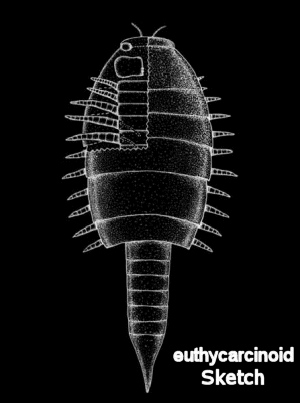
Friday, March 27, 2009
Fully equipped for fieldwork
Inspired by the latest post of my former college mate "Lost Geologist" i decided to carry on with this photo-meme. Here is my gear:


Friday, March 6, 2009
Traces First #2: On dry ground!
This is one of my favourite. I think this event is special for several instances. First of all, it must have been ONE event. Although quite more important, lifes complexity itself and the rise of metazoans as well as the Cambrian radiation are transitions. These progresses have many mothers and fathers and all are the result of (r)evolutionary teamwork of biotic and abiotic factors. The early terrestrialisation, however, had a chosen one that did it first.
The earliest convincing record of animals on land is described by MacNaughton et al. (2002) from the Cambro-Ordovician Nepean Formation of southeastern Ontario, Canada. They found arthropod trackways on bedding planes of sandstones that represent aolian desert deposits. Evidence for the sub-aerial origin is given by the presence of large scale high-angle trough cross-bedding, and moreover, adhesion marks and wind ripples.
The trackways itself are composed of a series of imprints (fig.1). There are some tracks possessing a continous midline interpreted as dragmark from posterior appendages. Interesting features of these walking traces are little bumps behind individual imprints. This suggests that the arthropod pushed the sediment backwards during walking which is virtually not likely to happen at a sediment surface that is covered with water. I think there is no doubt about the sub-aerial origin of these traces.
The earliest convincing record of animals on land is described by MacNaughton et al. (2002) from the Cambro-Ordovician Nepean Formation of southeastern Ontario, Canada. They found arthropod trackways on bedding planes of sandstones that represent aolian desert deposits. Evidence for the sub-aerial origin is given by the presence of large scale high-angle trough cross-bedding, and moreover, adhesion marks and wind ripples.
The trackways itself are composed of a series of imprints (fig.1). There are some tracks possessing a continous midline interpreted as dragmark from posterior appendages. Interesting features of these walking traces are little bumps behind individual imprints. This suggests that the arthropod pushed the sediment backwards during walking which is virtually not likely to happen at a sediment surface that is covered with water. I think there is no doubt about the sub-aerial origin of these traces.
The next question is who did it? The authors discussed several possibilities and favoured a group called Euthycarcinoidea which are placed within the crustaceans but are considered to be closely related to the earliest myriapods (fig.2).

Fig. 2: Euthycarcinoid Arthropods. link
A little bit of discussion is necessary here though. The Euthycarcinoids are probably traceable to the upper Cambrian (Vacarri et al. 2004). Accordingly, the trace fossils described by MacNaughton et al. (2002) may be slightly younger, which implies that the designated trace makers were present before the trackway reported by MacNaughton et al. (2002) was produced. However, there is no terrestrial body fossil described as early as upper Ordovician to Silurian. Furthermore, the alleged producer was not observed in situ with their traces up to now. It cannot be told if they truly did it. Except of smoking gun reports with in situ associations, I tend to be highly incredulous concerning trace-trace maker suggestions. Furthermore, the first terrestrial traces were most likely produced by amphibious arthropods that strolled around in back-beach areas or that were otherwise able to migrate into plains by swimming upstream. They were still predominantly aquatic organisms. However, they were (at least temporarily) able to deal with harsh conditions on land like high temperatures, increased gravity, the problem of respiration and higher impact of UV-radiation and so on.
References
Vacarri, N.E., Edgecombe G.D. and Escudero C., 2004: Cambrian origins and affinities of an enigmatic fossil group of arthropods, Nature 430, 554 – 557.
MacNaughton, R.B., Cole, J.M., Dalrymple, R.W., Braddy, S.J., Briggs, D.E.G., Lukie, T.D., 2002: First steps on land: Arthropod trackways in Cambrian-Ordovician eolian sandstone, southeastern Ontario, Canada. Geology 30/5, 391 – 394.
Labels:
Cambrian,
ichnology,
Palaeontology,
traces first
Subscribe to:
Posts (Atom)



